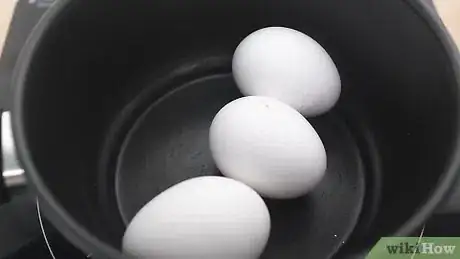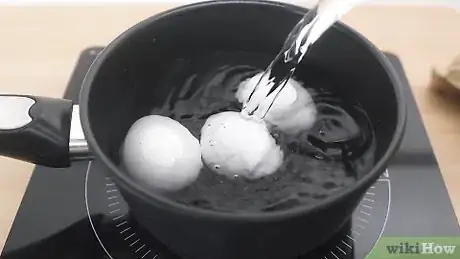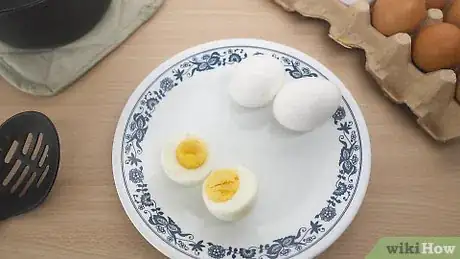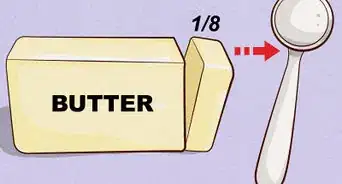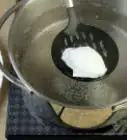This article was co-authored by Anne Lloyd. Chef Anne Lloyd is a Professional Chef and the Owner of Nolavore in New Orleans, Louisiana. Chef Anne has had a career in the restaurant and food service industries for over 30 years and has traveled and cooked on both coasts of the United States as well as in Europe and Southeast Asia. She specializes in utilizing local and regional foods to create dishes featuring international flavors. She also provides full-service catering, prepared foods, gourmet packaged goods, pantry items, and kids' cooking camps and classes for all ages. She received a BA in Anthropology from the University of California, Santa Cruz, and her Associate of Arts, Culinary Arts degree from the California Culinary Academy. Anne is an alumna of the Goldman Sachs 10,000 Small Businesses Summit.
There are 7 references cited in this article, which can be found at the bottom of the page.
wikiHow marks an article as reader-approved once it receives enough positive feedback. In this case, several readers have written to tell us that this article was helpful to them, earning it our reader-approved status.
This article has been viewed 2,075,538 times.
Boiled eggs are delicious, nutritious, and easy-to-make snacks. Whether you want firm, hard-boiled eggs or soft-boiled eggs with warm, runny yolks, a few simple steps will have you enjoying your savory treat in no time.
Steps
Hard-Boiled Eggs
-
1Place up to 6 eggs in a large saucepan. Make sure to use a saucepan large and deep enough to hold all your eggs in a single layer (not stacking any on top of the others) with some room for them to move around.[1] [2]
Use eggs that have been in your fridge for 1-2 weeks. Older eggs have less moisture and a higher pH, making their shells easier to peel off when you’re ready to eat.
-
2Cover the eggs with 1 inch (2.5 cm) of water. Place the pan in the sink and fill it with cool temperature water until the eggs are covered by about 1 inch (2.5 cm) of water.[3]
- The more eggs you boil, the more water you’ll need. If you’re using more than 6 eggs, cover them with 2 inches (5.1 cm) of water to ensure a good boil.
Advertisement -
3Add vinegar or salt to prevent the eggs from cracking. Add 1 teaspoon (4.9 mL) of vinegar or 1⁄2 teaspoon (2.5 mL) salt to keep the eggs from cracking in the pan. Adding salt also makes it easier to peel the eggs when you’re ready to eat![4]
-
4Bring the pan to a rolling boil on the stove for 10 minutes. Place the pan on the stove and heat it on high until the water gets to a rolling boil. You can leave the pan uncovered while you boil.[5]
- If you see an egg crack while you’re boiling, continue cooking it. Some of the white might slip out of the shell a bit, but it will be safe to eat as long as you cook it fully.
-
5Turn off the heat and let the eggs sit for 6-16 minutes. Once the water reaches a rolling boil, shut off the heat, cover the pan, and let it sit on the burner for 6-16 minutes, depending on how hard you like your eggs.[6]
- If you want your yolks a little translucent and runny in the middle, let them sit in the water for 6 minutes.
- If you want a classic hard-boiled egg with a firm yolk, let your eggs steep for 10-12 minutes.
- For hard, slightly crumbly yolks, keep your eggs in the water for 16 minutes.
-
6Strain the water and run the eggs under cold water. Pour the water out of the pan and run the eggs under cold water for a minute or so to stop them from cooking. Touch them gently to tell when they’re cool enough to handle.[7]
- To test if your eggs are done, remove one with a slotted spoon, run it under cold water, and cut it open with a knife. If the yolk isn’t done to your taste, let the other eggs sit for 1-2 more minutes.
- If you’re worried about your eggs rolling out when you strain, tilt the pan over the sink while holding the lid over the opening so that the water runs out through a crack.
- You can also cool your eggs by letting them sit in a bowl of ice water for 1-2 minutes.
-
7Store hard-boiled eggs in their shells in the refrigerator for up to a week. If you want to store your eggs, remove them from the water as soon as they’re cool. Set them back in their original carton to prevent them from absorbing other food odors and eat within 1 week.[8]
- Only store hard-boiled eggs that are still in their shell. Once you peel the shell off, you should make sure to eat the egg that day.
- If a hard-boiled egg feels slimy after you peel it, throw the egg away. This is a sign that bacteria have started to grow and the egg isn’t good.[9]
-
8Tap the egg on the counter and peel the shell under cold water. When you’re ready to eat, tap your egg gently on the counter to crack the shell, then roll it with the palm of your hand until the cracks have spread all over the egg. Then, hold the egg under running, room temperature water and peel the shell off.[10]
- If you’re still having trouble peeling your eggs, crack the shells and soak them in a pot of water for 10-15 minutes. Water will work under the shell, making it easier to peel off.[11]
-
9Eat hard-boiled eggs plain, as an appetizer, or on a salad. Hard-boiled eggs with a dash of salt and pepper are great for a quick, healthy snack. You can also cut them in half to make deviled eggs, or slice them up for a tasty salad topper.[12]
Soft-Boiled Eggs with Runny Yolks
-
1Pour water into a large saucepan and heat to a boil, then simmer. Fill your pan with enough water to cover the eggs by about 1 inch (2.5 cm). Set it on the stove over high heat. Once the water gets to a boil, lower the heat to a simmer.[13]
- Choose a saucepan that’s big enough to hold your eggs in a single layer. For a good measurement, set your eggs in the saucepan and fill it with water, then remove them before you start boiling.
-
2Add up to 4 eggs and let sit for 5-7 minutes. Use tongs or a spoon to set your eggs in the simmering water. Set a timer for 5-7 minutes, depending on how runny you want your yolk. If you’re boiling 3-4 eggs, add 15-30 seconds onto your time.[14]
- For a runny yolk, let your eggs boil for 5 minutes.
- For slightly firmer yolk, boil your eggs for 6-7 minutes.
- Soft-boil in batches if you want more than 4 eggs.
-
3Remove the eggs and run them under cold water for 1 minute. Use a slotted spoon to pull out your eggs one by one. Run them under cold tap water for 30 seconds to a minute so they stop cooking and are cool enough to handle.[15]
-
4Set the egg in a cup or small bowl and tap around the top to remove it. Place your egg upright in an egg cup or a small bowl filled with an uncooked grain, like rice, to keep it standing up. Tap the egg around the pointy top with a butter knife to loosen it, then pull it off with your fingers.[16]
- You won’t be able to store soft-boiled eggs, so eat them right away, while they’re still warm and gooey.
-
5Eat the egg right from the shell or with toast. To eat, simply spoon the egg right from the shell into your mouth. You can also slice toast into thin strips and dip them into the yolk.[17]
- If your egg is more firmly cooked, you can carefully crack it, peel the shell, and enjoy it on toast for a warm, savory breakfast treat.
Community Q&A
-
QuestionI just want to know if the eggs float when you put them in the water, are they still good eggs?
 Community AnswerNo. Fresh eggs sink in water. If it floats to the surface, it's bad.
Community AnswerNo. Fresh eggs sink in water. If it floats to the surface, it's bad. -
QuestionHow does boiling help the egg?
 Community AnswerIt's just a way to prepare the egg for eating. You should always cook eggs somehow before eating to kill the bacteria in them. Boiling is the simplest and healthiest method.
Community AnswerIt's just a way to prepare the egg for eating. You should always cook eggs somehow before eating to kill the bacteria in them. Boiling is the simplest and healthiest method. -
QuestionWhy don't microwaves boil things?
 Community AnswerMicrowaves will boil liquids, but every type of heat is not appropriate for every kind of cooking.
Community AnswerMicrowaves will boil liquids, but every type of heat is not appropriate for every kind of cooking.
Warnings
- Don’t pierce the shell before cooking. Though some recipes recommend this, using a non-sterile piercer can introduce bacteria into the egg. It also creates tiny cracks in the shell, which allow bacteria to enter after cooking.⧼thumbs_response⧽
- Don’t microwave an egg in its shell. The steam will build up inside the shell and make the egg explode.⧼thumbs_response⧽
Things You’ll Need
Hard-Boiled Eggs
- Large saucepan
- Eggs (however many can fit in your saucepan!)
- Water
- 1 teaspoon (4.9 mL) of vinegar or 1⁄2 teaspoon (2.5 mL) salt (optional)
- Slotted spoon
Soft-Boiled Eggs
- Large saucepan
- Eggs (up to 4 per batch)
- Water
- Timer
- Egg cup or small bowl filled with uncooked grain or rice
- Butter knife
References
- ↑ https://www.simplyrecipes.com/recipes/how_to_make_perfect_hard_boiled_eggs/
- ↑ https://www.thekitchn.com/5-mistakes-to-avoid-when-making-hard-boiled-eggs-cooking-mistakes-to-avoid-216999
- ↑ https://www.simplyrecipes.com/recipes/how_to_make_perfect_hard_boiled_eggs/
- ↑ https://www.simplyrecipes.com/recipes/how_to_make_perfect_hard_boiled_eggs/
- ↑ https://www.simplyrecipes.com/recipes/how_to_make_perfect_hard_boiled_eggs/
- ↑ https://www.simplyrecipes.com/recipes/how_to_make_perfect_hard_boiled_eggs/
- ↑ https://www.simplyrecipes.com/recipes/how_to_make_perfect_hard_boiled_eggs/
- ↑ https://www.incredibleegg.org/eggcyclopedia/s/storing/
- ↑ https://www.realsimple.com/food-recipes/shopping-storing/food/storing-hard-cooked-eggs
- ↑ https://www.realsimple.com/magazine-more/inside-magazine/ask-real-simple/ask-real-simple-peeling-hard-boiled-eggs
- ↑ https://www.simplyrecipes.com/recipes/how_to_make_perfect_hard_boiled_eggs/
- ↑ https://www.delish.com/holiday-recipes/easter/g2170/hard-boiled-egg-recipes/
- ↑ https://www.thekitchn.com/how-to-make-a-soft-boiled-egg-kitchn-cooking-lesson-138819
- ↑ https://www.thekitchn.com/how-to-make-a-soft-boiled-egg-kitchn-cooking-lesson-138819
- ↑ https://www.thekitchn.com/how-to-make-a-soft-boiled-egg-kitchn-cooking-lesson-138819
- ↑ https://www.thekitchn.com/how-to-make-a-soft-boiled-egg-kitchn-cooking-lesson-138819
- ↑ https://www.thekitchn.com/how-to-make-a-soft-boiled-egg-kitchn-cooking-lesson-138819
- ↑ https://www.simplyrecipes.com/recipes/how_to_make_perfect_hard_boiled_eggs/
- ↑ https://www.simplyrecipes.com/recipes/how_to_make_perfect_hard_boiled_eggs/
About This Article
"For delicious hard-boiled eggs, first put your eggs in a large saucepan and cover them with 1 inch of water. Bring the water to a boil, then turn off the heat. Cover the saucepan and let it sit for 6-15 minutes. Then, remove your eggs with a slotted spoon and submerge them in an ice bath to cool them down before handling. To make a soft-boiled egg, bring water to a boil. Then, decrease the heat to a simmer and add the eggs. Let simmer for 5-7 minutes. Cool the eggs down and enjoy! "
